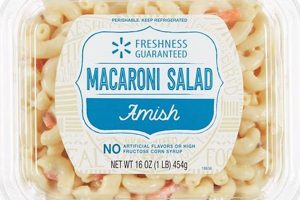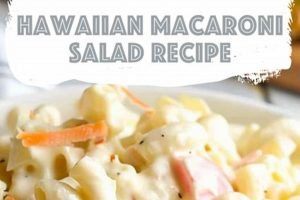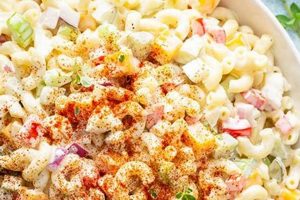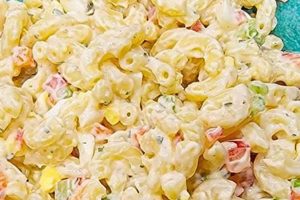A creamy, flavorful dressing is essential to a successful macaroni salad. This typically involves a combination of mayonnaise, vinegar, and seasonings, but variations can include mustard, sour cream, yogurt, or other emulsifying agents. Specific ingredients and their proportions determine the character of the salad, ranging from tangy and sharp to sweet and savory. For instance, a classic preparation might involve mayonnaise, cider vinegar, celery seed, onion powder, salt, and pepper.
The dressing binds the ingredients together, imparting flavor and moisture to the cooked pasta and other components like vegetables or proteins. A well-executed dressing elevates simple ingredients, transforming them into a cohesive and satisfying dish. Historically, mayonnaise-based salads gained popularity in the early 20th century with the increased availability of commercially produced mayonnaise. This convenience allowed for quick and easy preparation, contributing to the dish’s widespread adoption for picnics, potlucks, and everyday meals.
From exploring classic variations to innovative flavor profiles, the following sections will delve into the art of crafting the perfect dressing for macaroni salad. Topics include ingredient selection, preparation techniques, storage tips, and creative adaptations to suit various dietary needs and preferences.
Tips for Creating Exceptional Macaroni Salad Dressing
Achieving a well-balanced and flavorful macaroni salad hinges on the quality of its dressing. These tips offer guidance on enhancing flavor, texture, and overall appeal.
Tip 1: Balance Tang and Sweetness: A harmonious blend of acidity and sweetness is crucial. Achieve this balance by carefully adjusting vinegar or lemon juice alongside a touch of sugar or sweetener.
Tip 2: Embrace Emulsion Stability: A stable emulsion prevents the dressing from separating. Whisking ingredients together slowly and thoroughly, or using an immersion blender, ensures proper emulsification.
Tip 3: Seasoning Beyond the Basics: Elevate flavor profiles through thoughtful seasoning. Consider incorporating Dijon mustard, smoked paprika, garlic powder, or onion powder.
Tip 4: Fresh Herbs for Brightness: Fresh herbs add vibrancy and complexity. Finely chopped chives, dill, parsley, or tarragon complement the creamy base.
Tip 5: Texture Through Ingredients: Finely diced celery, red onion, or bell peppers introduce textural contrast.
Tip 6: Mindful Ingredient Incorporation: Add the dressing to the pasta while it is slightly warm. This allows the pasta to absorb flavors more effectively.
Tip 7: Chill for Flavor Development: Allow the salad to chill thoroughly before serving. Chilling enhances flavor cohesion and allows the ingredients to meld.
By employing these techniques, one can create a dressing that transforms ordinary macaroni salad into a culinary delight. Attention to detail ensures a harmonious balance of flavors, textures, and visual appeal.
These tips lay the foundation for crafting exceptional macaroni salad. The following section will explore specific recipe variations and address common queries.
1. Mayonnaise base
Mayonnaise serves as the foundational element in most macaroni salad dressings. Its creamy texture and emulsifying properties bind the other ingredients, creating a cohesive sauce that coats the pasta and other components. Mayonnaise also contributes a subtle tanginess and richness, enhancing the overall flavor profile. The quality of the mayonnaise directly impacts the final result; a high-quality mayonnaise, preferably one made with real eggs and oil, yields a superior dressing compared to lower-quality alternatives. For example, using a mayonnaise made with olive oil can impart a subtle fruity flavor, while a mayonnaise made with avocado oil offers a neutral taste and creamy texture. This foundational ingredient determines the overall richness and mouthfeel of the dressing.
The amount of mayonnaise used influences the consistency of the dressing. A higher mayonnaise-to-other-ingredient ratio produces a thicker, creamier dressing, while a lower ratio yields a thinner, more vinaigrette-like consistency. This adjustability allows for customization based on personal preference and the specific ingredients incorporated into the salad. For instance, a salad with heavier ingredients, like potatoes or hard-boiled eggs, may benefit from a thicker dressing, whereas a lighter salad with predominantly vegetables might be better suited to a thinner dressing. Understanding the impact of mayonnaise concentration allows for precise control over the final texture and consistency of the macaroni salad.
Selecting the appropriate mayonnaise and adjusting its proportion are critical steps in achieving a successful macaroni salad dressing. This base ingredient not only binds the components but also significantly influences the overall flavor, texture, and mouthfeel of the final dish. Challenges can arise from using low-quality mayonnaise, which can result in a thin, less flavorful dressing, or from improper ratios, which can lead to an overly thick or thin consistency. Mastering the use of mayonnaise as a base allows for the creation of a balanced and flavorful macaroni salad tailored to individual preferences.
2. Tangy Vinegar
Vinegar plays a crucial role in macaroni salad dressing, providing the necessary acidity to balance the richness of the mayonnaise and other ingredients. The sharp, tangy notes cut through the creamy texture, preventing the salad from becoming overly heavy or bland. Selecting the appropriate type and amount of vinegar significantly impacts the overall flavor profile.
- Types of Vinegar
Various vinegars offer distinct flavor profiles suitable for macaroni salad. Apple cider vinegar contributes a mild, fruity sweetness, while white vinegar offers a clean, sharp acidity. Red wine vinegar provides a more robust, complex flavor, and balsamic vinegar introduces a deeper, slightly sweeter tang. The choice depends on the desired overall taste of the salad.
- Balancing Acidity
The amount of vinegar requires careful consideration. Too much can make the salad excessively tart, while too little can result in a bland dressing. Balancing the acidity with the other ingredients, especially the mayonnaise and any added sweeteners, is key to achieving a harmonious flavor profile. Start with a small amount and adjust to taste, ensuring the vinegar complements rather than overwhelms the other flavors.
- Enhancing Flavor Complexity
Beyond providing acidity, vinegar can enhance the complexity of the dressing. Infused vinegars, such as those infused with herbs or fruits, add nuanced layers of flavor. For instance, a tarragon-infused vinegar can complement a salad with fresh herbs, while a raspberry-infused vinegar can add a subtle fruity note. These variations offer opportunities for creative flavor combinations.
- Impact on Texture and Preservation
The acidity of vinegar also contributes to the texture of the macaroni salad by subtly firming the pasta and other ingredients. Furthermore, vinegar acts as a natural preservative, extending the shelf life of the salad, a particularly beneficial attribute for picnics and potlucks.
The careful selection and application of vinegar are essential for creating a well-balanced and flavorful macaroni salad dressing. The right vinegar elevates the dish beyond a simple combination of ingredients, creating a complex interplay of flavors and textures. Understanding the nuances of different vinegar types and their impact on the overall composition allows for precise control over the final product, ensuring a delicious and satisfying culinary experience.
3. Balanced Sweetness
Balanced sweetness plays a vital role in a successful macaroni salad sauce recipe. It harmonizes with the acidity of the vinegar and the richness of the mayonnaise, preventing the dressing from being overly tart or bland. Achieving this balance is crucial for a palatable and enjoyable final product. The degree of sweetness can be adjusted to complement the other ingredients and suit individual preferences.
- Sugar’s Role
Granulated sugar is the most common sweetener used in macaroni salad dressings. It dissolves readily into the dressing, providing a clean, straightforward sweetness. Alternatives include powdered sugar for a smoother texture or liquid sweeteners like honey or maple syrup for a more nuanced flavor profile. However, liquid sweeteners can alter the dressing’s consistency and should be used judiciously. The amount of sugar used depends on the desired level of sweetness and the overall balance of flavors in the recipe.
- Balancing with Acidity
The sweetness in the dressing must be carefully balanced against the acidity of the vinegar. A successful recipe achieves a harmonious interplay between these two elements, preventing either from dominating. The precise ratio depends on the type of vinegar used; for instance, a milder vinegar like apple cider vinegar may require less sugar than a sharper white vinegar. Taste-testing and adjusting accordingly are crucial for achieving the desired balance.
- Impact on Flavor Profile
Sweetness contributes not only to the perceived sweetness of the dressing but also influences the overall flavor profile. It can enhance the savory notes of other ingredients, such as mustard or onion, and round out the overall taste. The interplay of sweet and savory elements creates a more complex and satisfying flavor experience.
- Considerations for Dietary Restrictions
Individuals with dietary restrictions may need to adjust the type and amount of sweetener used. Artificial sweeteners or sugar substitutes can be used for those limiting sugar intake, but their impact on flavor and texture should be considered. Alternatively, reducing the amount of vinegar and focusing on other flavor components can minimize the need for added sweetness.
The careful consideration of sweetness in a macaroni salad sauce recipe is essential for creating a well-rounded and flavorful dish. The right balance enhances the other ingredients, creating a harmonious blend of flavors that complements the pasta, vegetables, and any other components. Understanding the interplay of sweetness, acidity, and other flavors allows for a precisely tailored dressing that elevates the macaroni salad from simple to exceptional.
4. Complementary Spices
Complementary spices constitute a critical element in macaroni salad sauce recipes, contributing depth and complexity beyond the foundational ingredients. These spices enhance the overall flavor profile, balancing the creamy richness of the mayonnaise and the tang of the vinegar. Careful spice selection is crucial, considering individual preferences and the desired flavor outcome. Common choices include: ground mustard, offering a subtle pungency; paprika, contributing a smoky warmth; celery seed, lending an earthy herbaceousness; garlic and onion powder, providing savory depth; and black pepper, adding a touch of piquancy. The specific combination and proportions of these spices influence the final character of the dressing, ranging from classic to innovative. For example, a traditional recipe might emphasize celery seed and mustard, while a more contemporary version might incorporate smoked paprika and garlic powder. The interplay of these spices creates a multi-dimensional flavor experience.
The effectiveness of complementary spices relies on their careful integration into the sauce. Bloom in a small amount of hot water before incorporating them into the dressing, intensifies the flavor of ground spices. Alternatively, dry-roasting whole spices before grinding enhances their aromatic qualities. Freshly ground spices generally offer a more pronounced flavor compared to pre-ground versions. Overuse can overwhelm the other ingredients, while insufficient quantities might render them imperceptible. A balanced approach allows the spices to complement rather than dominate the overall taste. Furthermore, the specific spices chosen should harmonize with the other ingredients in the salad, such as vegetables or proteins. For instance, dill might pair well with salmon or cucumber, while paprika might complement bell peppers or ham. This holistic approach ensures a cohesive and well-rounded flavor profile throughout the dish.
Understanding the role and application of complementary spices enables the creation of nuanced and flavorful macaroni salad dressings. The judicious use of spices elevates the dish beyond basic ingredients, transforming it into a culinary expression. Challenges include achieving a harmonious balance of flavors and avoiding overpowering the other ingredients. However, thoughtful consideration and experimentation with different spice combinations unlock a wide range of flavor possibilities, allowing for customization and culinary creativity within the classic framework of macaroni salad. The strategic incorporation of spices ultimately determines the complexity and character of the final product.
5. Fresh Herbs (Optional)
Fresh herbs, while optional, offer a significant opportunity to elevate macaroni salad sauce recipes. Their inclusion introduces vibrant aromatic and flavor dimensions, transforming a simple dressing into a more complex and nuanced culinary experience. The judicious selection and application of fresh herbs can significantly impact the final product’s overall appeal.
- Herb Selection
The choice of herbs depends on the desired flavor profile and the other ingredients in the salad. Dill, parsley, chives, tarragon, and mint are popular options. Dill offers a slightly tangy, anise-like flavor that complements fish or cucumbers. Parsley provides a fresh, slightly peppery taste. Chives contribute a delicate onion flavor. Tarragon lends a subtle licorice note. Mint adds a refreshing coolness. Matching the herb’s flavor profile to the other salad components ensures a harmonious blend.
- Preparation and Incorporation
Fresh herbs should be added to the dressing just before serving to maximize their flavor and prevent wilting. Finely chopping the herbs ensures even distribution and prevents large pieces from overpowering the other ingredients. Alternatively, some herbs, like dill, can be incorporated whole if a more pronounced flavor is desired. Overuse can result in a dominant herbal taste, masking the other flavors in the dressing, so moderation is essential.
- Flavor Enhancement and Complexity
Fresh herbs not only add their own distinct flavors but also enhance the existing flavors in the dressing. They can brighten the overall taste, add a layer of freshness, and create a more complex and interesting flavor profile. For example, dill can enhance the creaminess of the mayonnaise, while chives can complement the tang of the vinegar. This interplay of flavors elevates the overall sensory experience.
- Visual Appeal
Beyond flavor, fresh herbs enhance the visual appeal of the macaroni salad. The bright green hues provide a welcome contrast to the creamy dressing and other ingredients, creating a more visually appealing and appetizing dish. This visual element contributes to the overall enjoyment of the salad.
While not strictly necessary, the addition of fresh herbs to macaroni salad sauce recipes represents a simple yet effective way to enhance both flavor and visual appeal. Careful selection and application of these herbs can transform a basic dressing into something truly special. Their inclusion offers a versatile pathway to culinary creativity and customization, allowing for a wide range of flavor combinations and visual presentations.
6. Creamy Texture
Creamy texture represents a defining characteristic of a successful macaroni salad sauce recipe. The perceived creaminess contributes significantly to the overall sensory experience, influencing palatability and enjoyment. Achieving the desired texture requires careful consideration of ingredient selection and preparation techniques.
- Mayonnaise as the Foundation
Mayonnaise serves as the primary source of creaminess in most macaroni salad dressings. Its emulsification of oil and egg yolks creates a smooth, viscous consistency that coats the pasta and other ingredients. The quality of mayonnaise directly impacts the final texture; higher-quality mayonnaise typically yields a richer, more luxurious creaminess. Alternatives, such as Greek yogurt or sour cream, can contribute to creaminess while offering a slightly tangier flavor profile.
- Emulsification and Stability
Proper emulsification is crucial for maintaining a stable and creamy texture. Thorough whisking or the use of an immersion blender ensures that the ingredients are fully incorporated and that the emulsion remains stable, preventing separation. Instability can lead to a watery or broken dressing, compromising the desired creamy consistency. Adding ingredients slowly and ensuring consistent blending motion contribute to a more stable emulsion.
- Additional Contributors to Creaminess
Other ingredients can further enhance the creamy texture. Adding a small amount of mashed avocado or ripe banana can contribute to both creaminess and flavor. Alternatively, incorporating a spoonful of cream cheese or softened butter can enrich the dressing and create a smoother mouthfeel. These additions should be balanced to avoid excessive richness or altering the intended flavor profile.
- Balancing Creaminess with Other Textural Elements
While creaminess is desirable, its essential to balance it with other textural elements within the salad. The inclusion of crunchy vegetables, such as celery or bell peppers, provides textural contrast, preventing the salad from becoming overly homogenous. This interplay of textures enhances the overall eating experience, creating a more dynamic and satisfying culinary experience.
The creamy texture of the sauce is integral to a well-executed macaroni salad. Achieving and maintaining this creaminess requires attention to detail throughout the preparation process, from ingredient selection to proper emulsification techniques. The balance of creaminess with other textural components ultimately contributes to the overall enjoyment and satisfaction derived from this classic dish.
7. Proper Emulsification
Proper emulsification is crucial for the stability and texture of macaroni salad dressing. A stable emulsion prevents the separation of ingredients, ensuring a smooth, creamy consistency that coats the pasta and other components effectively. Without proper emulsification, the dressing can become watery and unappetizing, detracting from the overall quality of the dish. This section explores the key facets of emulsification within the context of macaroni salad sauce recipes.
- Emulsion Stability: Preventing Separation
Emulsion stability refers to the ability of the dressing to remain cohesive and prevent the separation of its oil and water-based components. In macaroni salad dressing, mayonnaise typically acts as the emulsifier, its lecithin content binding the oil and vinegar together. A stable emulsion ensures a consistent texture throughout the salad, preventing oil from pooling on the surface or the dressing from becoming thin and watery. This stability is crucial for both visual appeal and palatable texture.
- Ingredients and Their Roles in Emulsification
The choice of ingredients directly influences the emulsion’s stability. High-quality mayonnaise, made with egg yolks and oil, provides a strong emulsifying base. The type of oil used also affects the emulsion; some oils, like olive oil, are more prone to separation than others, such as canola oil. The ratio of oil to vinegar also requires careful consideration. Too much oil can overwhelm the emulsifier’s capacity, leading to separation, while too little can result in a thin, less creamy dressing.
- Techniques for Achieving Proper Emulsification
Several techniques promote proper emulsification. Slow, gradual addition of oil to the other ingredients, while whisking constantly, encourages the formation of a stable emulsion. Using an immersion blender provides more efficient and consistent emulsification, particularly for larger batches. Maintaining a consistent temperature during preparation also aids stability; extreme temperature fluctuations can destabilize the emulsion.
- Impact on Texture and Flavor
Proper emulsification significantly impacts both the texture and flavor of the macaroni salad. A stable emulsion creates a smooth, creamy mouthfeel that coats the pasta evenly, distributing the flavor components throughout. A broken emulsion can result in an oily mouthfeel and uneven flavor distribution, detracting from the overall enjoyment of the dish.
Proper emulsification forms the foundation of a successful macaroni salad sauce recipe. By understanding the factors influencing emulsification and employing appropriate techniques, one can ensure a stable, creamy dressing that enhances the overall quality and enjoyment of the macaroni salad. A properly emulsified dressing not only improves the texture but also contributes to a more cohesive and balanced flavor profile, elevating the dish from simple to exceptional.
Frequently Asked Questions
This section addresses common inquiries regarding the preparation and storage of macaroni salad dressing, offering practical guidance for optimal results.
Question 1: How can one prevent macaroni salad dressing from becoming too watery?
Excess moisture from the pasta or other ingredients can dilute the dressing. Ensure the pasta is well-drained and cooled before combining it with the dressing. Adding ingredients like celery or cucumbers should be timed carefully, as their moisture content can also contribute to a watery consistency. A thicker dressing, achieved by adjusting the mayonnaise ratio, can offer greater resistance to dilution.
Question 2: What are suitable alternatives to mayonnaise in macaroni salad dressing?
Greek yogurt or sour cream offer lower-fat alternatives to mayonnaise, imparting a tangier flavor. Pureed avocado or silken tofu can create a vegan dressing option with a creamy texture. These alternatives may require adjustments to other ingredients to achieve the desired consistency and flavor balance.
Question 3: How long can macaroni salad be stored safely?
Macaroni salad, when properly refrigerated in an airtight container, typically remains safe for consumption for three to five days. However, the presence of perishable ingredients, such as hard-boiled eggs, might shorten this timeframe. Always assess the salad’s quality before consuming it after extended refrigeration.
Question 4: Can macaroni salad dressing be made ahead of time?
Preparing the dressing in advance is possible. Store it separately in an airtight container in the refrigerator for up to two days. Add the dressing to the pasta and other ingredients shortly before serving to maintain optimal texture and flavor.
Question 5: How can one adjust the flavor profile of macaroni salad dressing?
The flavor profile can be adjusted by incorporating various spices and herbs. Adding Dijon mustard provides a tangy complexity, while smoked paprika introduces a smoky depth. Fresh herbs, like dill or chives, add brightness and freshness. Adjusting the amount of vinegar or sweetener alters the balance of tang and sweetness. Experimentation is key to achieving the desired flavor.
Question 6: How does one achieve a smoother, more homogenous dressing?
A smooth, homogenous dressing results from proper emulsification. Whisking ingredients vigorously or using an immersion blender ensures thorough incorporation and a creamy texture. Adding ingredients gradually, especially oil-based components, while blending continuously, aids in creating a stable emulsion. Ensuring all ingredients are at a similar temperature also promotes a smooth and consistent texture.
Addressing these common queries provides clarity on crucial aspects of macaroni salad preparation and storage. Attention to detail throughout the process ensures optimal flavor, texture, and food safety.
The following section offers a selection of diverse macaroni salad sauce recipes.
Macaroni Salad Sauce Recipe
Exploration of macaroni salad sauce recipes reveals the critical interplay of ingredients and techniques in achieving a successful outcome. Mayonnaise establishes the foundational creaminess, balanced by the tang of vinegar. Sweetness harmonizes these elements, while complementary spices and optional fresh herbs add depth and complexity. Proper emulsification ensures a smooth, stable texture, preventing separation and contributing to a cohesive final product. Ingredient quality, precise measurements, and thoughtful preparation techniques influence flavor, texture, and overall appeal. Addressing common challenges, such as preventing watery consistency and maximizing shelf life, further refines the culinary process. Customization through spice variations, herb additions, and alternative emulsifying agents expands the possibilities within this classic dish.
Macaroni salad, often perceived as a simple side dish, offers a canvas for culinary expression. Mastery of the sauce recipe unlocks potential for flavor exploration and personalized adaptations. Continued experimentation with ingredients and techniques elevates this versatile dish, transforming it from a humble picnic staple into a culinary creation reflecting individual creativity and expertise. The seemingly straightforward combination of ingredients belies a complex interplay of flavors and textures, inviting culinary enthusiasts to explore and refine their approach to this classic dish.






